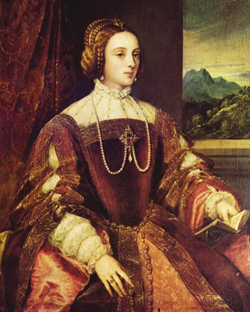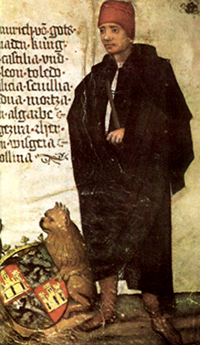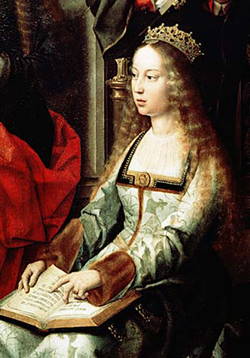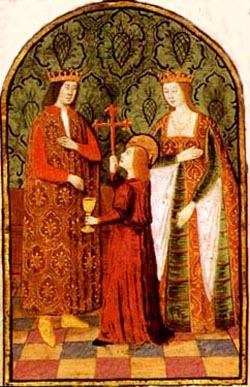 |
Formation of Children
Isabel of Castile’s Childhood
A Model for Catholic Families
Marian T. Horvat
What would happen to my children if they were taken from me by the government?”
This is a question that until some years ago one would expect to hear only in a Communist country, where the State police intrudes upon the life of the family to control what parents teach their children. But this problem is becoming increasingly common in our country as well, the so-called “land of liberty.”
Indeed, I have heard this question asked more than once recently from concerned Catholic mothers whom I know. A fear hovers in the air that State officials - acting on information that parents are religious radicals, teaching intolerance, preaching hate, withholding vaccines, or any number of these “new crimes” – could take their children from them.

Americans are increasingly threatened by state invasion into their private lives |
Every day such biased accusations become more and more likely to be applied against any Catholic family that teaches traditional moral doctrine to their children.
We Catholics should fight against these communist laws that are being introduced. At first they can appear to protect children at risk. In fact, they aim to destroy the parents’ power in the home and permit the State to assume control over the formation of their children. I encourage Catholic parents to be very vigilant regarding such laws and oppose them.
I also encourage parents to continue teaching their children Catholic doctrine, especially the pure and healthy norms of Catholic Morals, so contrary to the modern pedagogy and mentality.
A Catholic father or mother naturally worries that if their children are introduced into a modern environment, they could abandon the faith. Wouldn’t it be impossible for them to uphold different standards and principles from those they see around them?
I provide you a beautiful historic example to show such resistance is possible, as well as to reinforce the importance of a strong Catholic formation of youth. Isabel of Castile and her brother Alfonso offer us a beautiful example of children who remained faithful to Catholic teaching when placed in an extremely hostile environment.
The good formation given by Queen Isabel of Portugal
After the death of her husband King Juan II of Castile, Queen Isabel of Portugal saw the son of his first marriage - her step-son Enrique IV - crowned King of Castile. Realizing the dangers for herself and two young children at this court of intrigues and vices, she withdrew with her two children to the small Castle of Arévalo in Old Castile. At that time, her daughter the Infanta Isabel was a self-assured little girl of three years and her son, Infante Alfonso, was a newborn in the cradle.

Queen Isabel of Portugal: pious, energetic and without compromise |
The valorous and pious Queen Isabel of Portugal, overcome by melancholy and ill health, turned to religion for solace. (1) She had never fully recovered from a suspected poisoning at court some years earlier that had affected her mental state. Nonetheless, she did her best to form her two children well. One of Isabella’s strongest memories of their mother was seeing her in the chapel, kneeling in reverence before the Holy Eucharist. (2)
Within the walled gates of the secluded castle, the children played games, learned their Catechism, received their First Communions in the chapel. Outside the walls, they took long outings on horseback, and Isabel became an excellent rider and skilled huntress. Her brother Alfonso learned to handle a sword and tilt with lances. Despite the very troubled times, it was a relatively serene and pious environment for the young Infante and Infanta.
At the court of King Enrique IV the Liberal, as he was called, it was a different story.
His unorthodox opinions and conduct scandalized the Catholic nobles and people. His chosen companions were Moors, Jews and Christian renegades; his private guard was composed of Arabs – to the outrage of the Catholic nobles. At his table, blasphemies against the Faith and obscene jokes were welcome.

Enrique IV, known for his depraved customs |
Further, the King was familiar with all vices, natural and unnatural. The stench of sin from this court – with scandals too numerous and vile to record – was sickening all of Castile.
The stories and rumors found their way even to the out-of-the-way Castle of Arévalo where Queen Isabel of Portugal had retreated with her children, who were next in line to the throne.
One day, King Enrique, desiring a closer hand on the lives of his half-siblings, sent a message to Queen Isabel of Portugal. He ordered the Infanta Isabel and the Infante Alfonso to come to the Royal Court without delay to take up permanent residence in that den of iniquity and intrigue. Ironically, the King pretended the children would be more virtuously brought up at his court under his personal care. Isabel was 11-years-old, and her bother was 8.
There was nothing to do but obey. Broken-hearted, the pious Queen Isabella sent off her children to face an impious court with untold dangers. She turned to prayer as her consolation, asking Our Lady to guide and protect the young Isabel and Alfonso.
At the court of Enrique IV
The life the two children entered at Alcazar of Segovia was very different from the austere and sheltered existence they had experienced up to then. Every day there were new blasphemies, new whispers of Queen Juana’s love affairs, new jokes about King Enrique’s impotence and fondness for young men. The young women of the court were famous for their skills in the art of seduction, their lascivious costumes and audacious speech.

Isabel shunned the corrupt court life; she found solace in study and prayer |
Infanta Isabel and her brother turned their backs on the debauched court life. Alfonso learned the skills of a knight, studied with a tutor and tried to fulfill the obligation his mother had given him to be Isabel’s knight and protector. Isabel was instructed in music, painting, poetry, sewing and grammar. She spent a long time every day in prayer, beseeching the Blessed Virgin to keep her and Alfonso safe and without sin.
The following incident offers a poignant picture of the fidelity of these two valiant youth to the upright customs and morals they learned from their mother.
When Isabel reached age 16, Queen Juana attempted to induce her to join the Court debaucheries. Isabel fled in tears to her brother.
Alfonso buckled on his sword and strode to the Queen’s apartment. One can imagine the picture. The stern-faced 12-year-old youth censured the Queen and forbade her to mention any further evil to his sister. The bemused Queen received his impassioned speech with an ironic smile – after all, one had to be careful in crossing the next in line to the throne. Next, he visited the ladies-in-waiting and forbade them under pain of death to speak to his sister of depraved things. They held back their laughter until he left. After that, however, Isabel was left alone.
Thus, amid a corrupt, scheming and debauched court, Isabel and her brother Alfonso emerged unscathed by the scandals and faithful to the teachings of the Catholic Faith. It was a triumph of grace that even in that rotten environment two strong pure Castilian roses prospered and blossomed, fortified by the prayers of their mother and the benefits of their early formation.
The fates of the Alfonso and Isabella
Alfonso later became involved in a plot with Catholic nobles who were fed up with Enrique’s unnatural vices and corrupt court and wanted to depose him and make Alfonso the king. Adding fuel to the fire was the fact that Queen Juana gave birth to a daughter – also named Juana – who was said not to be the daughter of King Enrique, but rather the offspring of the Queen’s favorite, Bertrand de la Cueva.

The Catholic Monarchs Ferdinand II of Aragon and Isabel I of Castile and León |
After a military confrontation between the two factions at the Battle of Olmedo in 1467 that ended in a draw, a truce was reached. To appease the rebellious nobles, Enrique agreed to name Alfonso as his heir. Shortly afterward, however, Alfonso became violently ill and died at age 15. Was it an attack of the summer fever or poisoning, as his supporters suspected? No one can say for sure.
The nobles then turned to Isabel to take her brother’s place at the head of their rebellion. But she refused and settled instead with Enrique IV. In an official agreement, she and the nobles accepted him as King, and he named her as his official heir.
In 1474, Isabel became Queen of Castile at age 26. She was a key character in completing the Reconquista, establishing the Spanish Inquisition, sponsoring Columbus' voyages that led to the discovery of America, and laying the foundations of the Spanish Empire. Throughout her reign, she upheld and defended the Catholic Faith that she had preserved as a child in a court very different from the one she would later establish.
For their fidelity to the Faith, Pope Alexander VI granted the title of Catholic Monarchs to Queen Isabel and her husband King Ferdinand. Thenceforward, the Spanish Monarchs were known by this title of honor. And because of her uncompromising faithfulness, she is known today as Isabel la Católica, Isabel the Catholic.
1. In her earlier years, Queen Isabel’s friendship with Saint Beatriz de Silva, whom she helped to found the order of the Conceptionists, played an influential role in her religious formation.
2. The other facts in this article are from William Thomas Walsh, The Last Crusader: Isabella of Spain (1452-1504), TAN: 1980.

Posted July 29, 2008

Related Topics of Interest
 St. Therese of the Child Jesus: Master of Her Temperament St. Therese of the Child Jesus: Master of Her Temperament
 The Moral Education of the Squire The Moral Education of the Squire
 Courtesy: An Essential Element of the Catholic Home Courtesy: An Essential Element of the Catholic Home
 A Man’s Bearing Reflects His Education and Virtue A Man’s Bearing Reflects His Education and Virtue
 Teaching Obedience to Children Teaching Obedience to Children
 The Era of the Child The Era of the Child

Related Works of Interest
|
|
Manners | Cultural | Home | Books | CDs | Search | Contact Us | Donate

© 2002- Tradition in Action, Inc. All Rights Reserved
|
 |
|